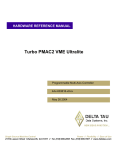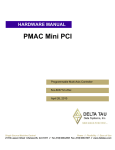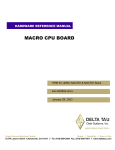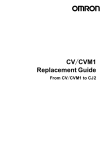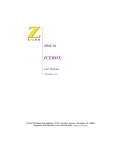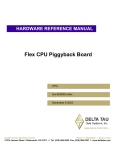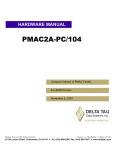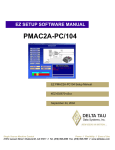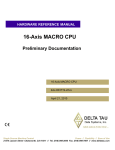Download Delta Tau PMAC2A User's Manual
Transcript
^1 HARDWARE REFERENCE MANUAL PMAC2A-PC/104 CPU ^3 PMAC2A-PC/104 CPU Hardware Reference ^4 4xx-603670-xAxx ^5 July 29, 2008 Single Source Machine Control Power // Flexibility // Ease of Use 21314 Lassen Street Chatsworth, CA 91311 // Tel. (818) 998-2095 Fax. (818) 998-7807 // www.deltatau.com Copyright Information © 2008 Delta Tau Data Systems, Inc. All rights reserved. This document is furnished for the customers of Delta Tau Data Systems, Inc. Other uses are unauthorized without written permission of Delta Tau Data Systems, Inc. Information contained in this manual may be updated from time-to-time due to product improvements, etc., and may not conform in every respect to former issues. To report errors or inconsistencies, call or email: Delta Tau Data Systems, Inc. Technical Support Phone: (818) 717-5656 Fax: (818) 998-7807 Email: [email protected] Website: http://www.deltatau.com Operating Conditions All Delta Tau Data Systems, Inc. motion controller products, accessories, and amplifiers contain static sensitive components that can be damaged by incorrect handling. When installing or handling Delta Tau Data Systems, Inc. products, avoid contact with highly insulated materials. Only qualified personnel should be allowed to handle this equipment. In the case of industrial applications, we expect our products to be protected from hazardous or conductive materials and/or environments that could cause harm to the controller by damaging components or causing electrical shorts. When our products are used in an industrial environment, install them into an industrial electrical cabinet or industrial PC to protect them from excessive or corrosive moisture, abnormal ambient temperatures, and conductive materials. If Delta Tau Data Systems, Inc. products are exposed to hazardous or conductive materials and/or environments, we cannot guarantee their operation. REVISION HISTORY REV. 1 DESCRIPTION UPDATED JUMPER DESCRIPTIONS PGS. 6 & 30 DATE CHG APPVD 05/17/06 CP S. MILICI 2 REVS: J4, E20-23, CONNECTOR PINOUTS, & BOARD DIAGRAMS 10/04/06 CP P. SHANTZ 3 CORRECTED TYPO IN I-VARIABLE SETTINGS, P. 17 01/22/08 CP S.MILICI 4 CORRECTED USER FLAGS FOR PINS 25 & 26, P.36 07/29/08 CP C.COKER PMAC2A PC104 Hardware Reference Manual Table of Contents INTRODUCTION .......................................................................................................................................................1 Board Configuration..................................................................................................................................................1 Base Version .........................................................................................................................................................1 Board Options ...........................................................................................................................................................1 Option 2A: PC/104 Bus Stack Interface ..............................................................................................................1 Option 5xF: CPU Speed Options.........................................................................................................................1 Option 6: Extended Firmware Algorithm ............................................................................................................1 Option 6L: Multi-block Lookahead Firmware.....................................................................................................1 Option 10: Firmware Version Specification.........................................................................................................2 Option 12: Analog-to-Digital Converters.............................................................................................................2 Additional Accessories..............................................................................................................................................2 Acc-1P: Axis Expansion Piggyback Board...........................................................................................................2 Acc-2P: Communications Board .........................................................................................................................2 Acc-8TS Connections Board.................................................................................................................................3 Acc-8ES Four-Channel Dual-DAC Analog Stack Board......................................................................................3 Acc-8FS Four-Channel Direct PWM Stack Breakout Board................................................................................3 HARDWARE SETUP .................................................................................................................................................5 Clock Configuration Jumpers....................................................................................................................................5 Reset Jumpers............................................................................................................................................................5 CPU Configuration Jumpers .....................................................................................................................................6 Communication Jumpers...........................................................................................................................................6 ADC Configuration Jumpers.....................................................................................................................................6 Encoder Configuration Jumpers ................................................................................................................................6 Single-Ended Encoders.........................................................................................................................................6 Differential Encoders............................................................................................................................................6 MACHINE CONNECTIONS.....................................................................................................................................9 Mounting ...................................................................................................................................................................9 Power Supplies..........................................................................................................................................................9 Digital Power Supply............................................................................................................................................9 DAC Outputs Power Supply .................................................................................................................................9 Flags Power Supply............................................................................................................................................10 Overtravel Limits and Home Switches....................................................................................................................10 Types of Overtravel Limits..................................................................................................................................10 Home Switches....................................................................................................................................................10 Motor Signals Connections .....................................................................................................................................10 Incremental Encoder Connection .......................................................................................................................10 DAC Output Signals ...........................................................................................................................................11 Pulse and Direction (Stepper) Drivers ...............................................................................................................11 Amplifier Enable Signal (AENAx/DIRn).............................................................................................................11 Amplifier Fault Signal (FAULT-) .......................................................................................................................12 Optional Analog Inputs ...........................................................................................................................................12 Compare Equal Outputs ..........................................................................................................................................12 Serial Port (JRS232 Port) ........................................................................................................................................12 Machine Connections Example: Using Analog ±10V Amplifier ............................................................................13 Machine Connections Example: Using Pulse and Direction Drivers ......................................................................14 SOFTWARE SETUP ................................................................................................................................................15 PMAC I-Variables...................................................................................................................................................15 Communications......................................................................................................................................................15 Operational Frequency and Baud Rate Setup ....................................................................................................15 Filtered DAC Output Configuration........................................................................................................................16 Parameters to Set up Global Hardware Signals.................................................................................................17 Parameters to Set Up Per-Channel Hardware Signals ......................................................................................18 Table of Contents i PMAC2A PC104 Hardware Reference Manual Effects of Changing I900 on the System .............................................................................................................18 How does changing I900 effect other settings in PMAC ....................................................................................20 Effects of Output Resolution and Servo Interrupt Frequency on Servo Gains....................................................21 Using Flag I/O as General-Purpose I/O...................................................................................................................22 Analog Inputs Setup ................................................................................................................................................22 CPU Analog Inputs.............................................................................................................................................22 HARDWARE REFERENCE SUMMARY .............................................................................................................23 Board Dimensions ...................................................................................................................................................23 From v106 to 107................................................................................................................................................23 From v107 to 108................................................................................................................................................24 From v108 to 109................................................................................................................................................25 Board Layout...........................................................................................................................................................26 Connectors and Indicators .......................................................................................................................................27 J3 - Machine Connector (JMACH1 Port)...........................................................................................................27 J4 - Machine Connector (JMACH2 Port)...........................................................................................................27 J8 - Serial Port (JRS232 Port)............................................................................................................................27 TB1 – Power Supply Terminal Block (JPWR Connector) ..................................................................................27 LED Indicators ...................................................................................................................................................27 E-POINT JUMPER DESCRIPTIONS ....................................................................................................................29 E0: Forced Reset Control .......................................................................................................................................29 E1: Servo and Phase Clock Direction Control .......................................................................................................29 E2: CPU Frequency Select .....................................................................................................................................29 E3: Normal/Re-Initializing Power-Up/Reset..........................................................................................................29 E4: CPU Frequency Select .....................................................................................................................................30 E8: Phase Clock Lines Output Enable....................................................................................................................30 E9: Servo Clock Lines Output Enable....................................................................................................................30 E10 – E12: Power-Up State Jumpers .....................................................................................................................30 E13: Power-Up/Reset Load Source........................................................................................................................31 E14: Watchdog Disable Jumper .............................................................................................................................31 E15A, B, C: Flash Memory Bank Select................................................................................................................31 E16: ADC Inputs Enable.........................................................................................................................................31 E18 – E19: PC/104 Bus Address............................................................................................................................32 E20-E23: ENCODER SINGLE ENDED/DIFFERENTIAL SELECT (Note: v107 and above only) ..............32 CONNECTOR PINOUTS.........................................................................................................................................33 TB1 (JPWR): Power Supply ..................................................................................................................................33 J4 (JRS232) Serial Port Connector..........................................................................................................................33 J3 (JMACH1): Machine Port Connector .................................................................................................................34 J3 JMACH1 (50-Pin Header) ..................................................................................................................................35 J4 (JMACH2): Machine Port CPU Connector ........................................................................................................36 SCHEMATICS ..........................................................................................................................................................38 ii Table of Contents PMAC2A PC104 Hardware Reference Manual INTRODUCTION The PMAC2A PC/104 motion controller is a compact, cost-effective version of Delta Tau’s PMAC2 family of controllers. The PMAC2A PC/104 can be composed of three boards in a stack configuration. The CPU provides four channels of either DAC ±10V or pulse and direction command outputs. The optional axis expansion board provides a set of four additional servo channels and I/O ports. The optional communications board provides extra I/O ports and either the USB or Ethernet interface for faster communications. Board Configuration Base Version The base version of the PMAC2A PC/104 ordered with no options provides a 90mm x 95mm board with: • 40 MHz DSP563xx CPU (80 MHz 560xx equivalent) • 128k x 24 internal zero-wait-state SRAM • 512k x 8 flash memory for user backup and firmware • Latest released firmware version • RS-232 serial interface • Four channels axis interface circuitry, each including: • 12-bit ±10V analog output • Pulse-and-direction digital outputs • 3-channel differential/single-ended encoder input • Four input flags, two output flags • Three PWM top-and-bottom pairs (unbuffered) PMAC2A-PC/104 Base Board shown • 50-pin IDC header for amplifier/encoder interface • 34-pin IDC header for flag interface • PID/notch/feed forward servo algorithms • 1-year warranty from date of shipment • One CD-ROM per set of one to four PMACs in shipment (Cables, mounting plates, mating connectors not included) Board Options Option 2A: PC/104 Bus Stack Interface Option 2A provides the PC/104 bus interface allowing bus communications between a PC/104 type computer and the PMAC2A PC/104 motion controller. Option 5xF: CPU Speed Options • • Option 5CF: 80 MHz DSP563xx CPU (160 MHz 56002 equivalent) Option 5EF: 160 MHz DSP563xx CPU (320 MHz 56002 equivalent) Option 6: Extended Firmware Algorithm Option 6 provides an Extended (Pole-Placement) Servo Algorithm firmware instead of the regular servo algorithm firmware. This is required only in difficult-to-control systems (resonances, backlash, friction, disturbances, changing dynamics). Option 6L: Multi-block Lookahead Firmware Option 6L provides a special lookahead firmware for sophisticated acceleration and cornering profiles execution. With the lookahead firmware PMAC controls the speed along the path automatically (but without changing the path) to ensure that axis limits are not violated. Introduction 1 PMAC2A PC104 Hardware Reference Manual Option 10: Firmware Version Specification Normally the PMAC2A PC/104 is provided with the newest released firmware version. A label on the memory IC shows the firmware version loaded at the factory. Option 10 provides for a user-specified firmware version. Option 12: Analog-to-Digital Converters Option 12 permits the installation of two channels of on-board analog-to-digital converters with ±10V input range and 12-bits resolution. The key component installed with this option is U20. Additional Accessories Acc-1P: Axis Expansion Piggyback Board Acc-1P provides four additional channels axis interface circuitry for a total of eight servo channels, each including: • 12-bit ±10V analog output • Pulse-and-direction digital outputs • 3-channel differential/single-ended encoder input • Four input flags, two output flags • Three PWM top-and-bottom pairs (unbuffered) Acc-1P Option 1: I/O Ports Option 1 provides the following ports on the Acc-1P axes expansion board for digital I/O connections. • Multiplexer Port: This connector provides eight input lines and eight output lines at TTL levels. When using the PMAC Acc-34x type boards these lines allow multiplexing large numbers of inputs and outputs on the port. Up to 32 of the multiplexed I/O boards may be daisy-chained on the port, in any combination. • I/O Port: This port provides eight general-purpose digital inputs and eight general-purpose digital outputs at 5 to 24Vdc levels. This 34-pin connector was designed for easy interface to OPTO-22 or equivalent optically isolated I/O modules when different voltage levels or opto-isolation to the PMAC2A PC/104 is necessary. • Handwheel port: this port provides two extra channels, each jumper selectable between encoder input or pulse output. Acc-1P Option 2: Analog-to-Digital Converters Option 2 permits the installation on the Acc-1P of two channels of analog-to-digital converters with ±10V input range and 12-bits resolution. The key component installed with this option is U20. Acc-2P: Communications Board Without any options, the PMAC2A PC/104 communicates through the RS-232 serial interface (using the optional Acc-3L flat cable) or PC/104 bus. This board provides added communication and I/O features. Acc-2P Option 1A: USB Interface Option 1A it provides a 480 Mbit/sec USB 2.0 interface. Acc-2P Option 1B: Ethernet Interface Option 1B provides a 100 Mbit/sec Ethernet. Acc-2P Option 2: DPRAM Circuitry Option 2 provides an 8K x 16 dual-ported RAM used with USB, Ethernet or PC/104 bus applications. If using for USB or Ethernet communications, Acc-2P-Opt-1A or Acc-2P-Opt-1B must be ordered. If used 2 Introduction PMAC2A PC104 Hardware Reference Manual for PC/104-bus communications, PMAC2A PC/104 Option-2A must be ordered. The key component installed with this option is U17. USB/Ethernet and PC/104 bus communications cannot be made simultaneously it is jumper selectable. Acc-2P Option 3: I/O Ports Option 3 provides the following ports on the Acc-2P communications board for digital I/O connections. • Multiplexer Port: this connector provides eight input lines and eight output lines at TTL levels. When using the PMAC Acc-34x type boards these lines allow multiplexing large numbers of inputs and outputs on the port. Up to 32 of the multiplexed I/O boards may be daisy-chained on the port, in any combination. • I/O Port: this port provides 16 general-purpose digital I/O lines at TTL levels and these can be configured as all inputs, all outputs or eight inputs and eight outputs. • Handwheel port: this port provides two extra channels, each jumper selectable between encoder input or pulse output. Acc-8TS Connections Board Acc-8TS is a stack interface board to for the connection of either one or two Acc-28B A/D converter boards. When a digital amplifier with current feedback is used, the analog inputs provided by the Acc28B cannot be used. Acc-8ES Four-Channel Dual-DAC Analog Stack Board Acc-8ES provides four channels of 18-bit dual-DAC with four DB-9 connectors. This accessory is stacked to the PMAC2A PC/104 board and it is mostly used with amplifiers that require two ±10 V command signals for sinusoidal commutation. Acc-8FS Four-Channel Direct PWM Stack Breakout Board Acc-8FS it is a 4-channel direct PWM stack breakout board for PMAC2A PC/104. This is used for controlling digital amplifiers that require direct PWM control signals. When a digital amplifier with current feedback is used, the analog inputs provided by the Option 12 of the PMAC2A PC/104 (the Option 2 of the Acc-1P or the Acc-28B) could not be used. Introduction 3 PMAC2A PC104 Hardware Reference Manual 4 Introduction PMAC2A PC104 Hardware Reference Manual HARDWARE SETUP On the PMAC2 PC/104 CPU, there are a number of jumpers called E-points or W-points. That customize the hardware features of the CPU for a given application and must be setup appropriately. The following is an overview grouped in appropriate categories. For an itemized description of the jumper setup configuration, refer to the E-Point Descriptions section. Clock Configuration Jumpers E1: Servo and Phase Clock Direction Control – Jumper E1 should be OFF if the board is to use its own internally generated phase and servo clock signals. In this case, these signals are output on spare pins on the J8 RS-232 serial-port connector, where they can be used by other PMAC controllers set up to take external phase and servo clock signals. Jumper E1 should be ON if the board is to use externally generated phase and servo clock signals brought in on the J8 RS-232 serial port connector. In this case, typically the clock signals are generated by another PMAC controller and output on its serial port connector. If E1 is ON for external phase and clock signals, and these clock signals are not brought in on the serial port connector, the watchdog timer will trip almost immediately and shut down the board. E2 and E4: CPU Frequency Control Jumpers – When the PMAC I46 I- variable is set to zero jumpers E2 and E4 on the base PMAC2A PC/104 board control the frequency at which the CPU will operate (or attempt to operate). Generally, this will be the highest frequency at which the CPU is rated to operate. Note that it is always possible to operate a CPU at a frequency lower than its maximum rating. While it may be possible to operate an individual processor at a frequency higher than its maximum rating, particularly at low ambient temperatures, performance cannot be guaranteed at such a setting, and this operation is done completely at the user’s own risk. • If jumpers E2 and E4 are both OFF, the CPU will operate at a 40 MHz frequency. • If E2 is ON and E4 is OFF, the CPU will operate at a 60 MHz frequency. • If E2 is OFF and E4 is ON, the CPU will operate at an 80 MHz frequency. If I46 is set to a value greater than 0, the operational frequency is set to 10MHz * (I46 + 1), regardless of the jumper setting. See the Software Setup section for details on this. E8: Phase Clock Lines Output Enable – Jump pin 1 to 2 to enable the Phase clock line on the J8 connector. Remove jumper to disconnect the Phase clock line on the J8 connector. E9: Servo Clock Lines Output Enable – Jump pin 1 to 2 to enable the Servo clock line on the J8 connector. Remove jumper to disconnect the Servo clock line on the J8 connector. Reset Jumpers E0: Forced Reset Control – Remove E0 for normal operation. Installing E0 forces PMAC to a reset state, this configuration is for factory use only; the board will not operate with E0 installed. E3: Re-Initialization on Reset Control – If E3 is OFF (default), PMAC executes a normal reset, loading active memory from the last saved configuration in non-volatile flash memory. If E3 is ON, PMAC re-initializes on reset, loading active memory with the factory default values. E13: Firmware Load Jumper – If jumper E13 is ON during power-up/reset, the board comes up in bootstrap mode which permits loading of firmware into the flash-memory IC. When the PMAC Executive program tries to establish communications with a board in this mode, it will detect automatically that the board is in bootstrap mode and ask what file to download as the new firmware. Jumper E13 must be OFF during power-up/reset for the board to come up in normal operational mode. Hardware Setup 5 PMAC2A PC104 Hardware Reference Manual CPU Configuration Jumpers E15A-E15C: Flash Memory Bank Select Jumpers – The flash-memory IC in location U10 on the PMAC2A PC/104 base board has the capacity for eight separate banks of firmware, only one of which can be used at any given time. The eight combinations of settings for jumpers E15A, E15B, and E15C select which bank of the flash memory is used. In the factory production process, firmware is loaded only into Bank 0, which is selected by having all of these jumpers OFF. E10-E12: Power-Up State Jumpers – Jumper E10 must be OFF, jumper E11 must be ON, and jumper E12 must be ON, in order for the CPU to copy the firmware from flash memory into active RAM on powerup/reset. This is necessary for normal operation of the card. (Other settings are for factory use only.) E14: Watchdog Timer Jumper – Jumper E14 must be OFF for the watchdog timer to operate. This is a very important safety feature, so it is vital that this jumper be OFF for normal operation. E14 should only be put ON to debug problems with the watchdog timer circuit. W1: Flash chip select – Jumper W1 in position 1-2 selects a 28F320J3A part for the U10 flash chip. Jumper W1 in position 2-3 selects a 28F320J5A part for the U10 flash chip. This jumper is installed in the factory and must not be changed from its default state. Communication Jumpers E18-E19: PC/104 Bus Base Address Control – Jumpers E18 and E19 on the PMAC2A PC/104 CPU determine the base address of the card in the I/O space of the host PC. Together, they specify four consecutive addresses on the bus where the card can be found. The jumpers form the base address in the following fashion: E18 E19 Address (hex) Address (dec.) OFF OFF ON ON OFF ON OFF ON $200 $210 $220 $230 512 528 544 560 The default base address is 528 ($210) formed with jumper E18 removed and E19 installed. This setting is necessary when using the USB or Ethernet ports of the Acc-2P communications board. ADC Configuration Jumpers E16: ADC Enable Jumper – Install E16 to enable the analog-to-digital converter circuitry ordered through Option-12. Remove this jumper to disable this option, which might be necessary to control motor 1 through a digital amplifier with current feedback. Encoder Configuration Jumpers E20-E23: Encoder Single Ended/Differential Select – PMAC has differential line receivers for each encoder channel, but can accept either single-ended (one signal line per channel) or differential (two signal lines, main and complementary, per channel). A jumper for each encoder permits customized configurations, as described below. Single-Ended Encoders With the jumper for an encoder set for single-ended, the differential input lines for that encoder are tied to 2.5V; the single signal line for each channel is then compared to this reference as it changes between 0 and 5V. When using single-ended TTL-level digital encoders, the differential line input should be left open, not grounded or tied high; this is required for The PMAC differential line receivers to work properly. Differential Encoders Differential encoder signals can enhance noise immunity by providing common-mode noise rejection. Modern design standards virtually mandate their use for industrial systems, especially in the presence of PWM power amplifiers, which generate a great deal of electromagnetic interference. 6 Hardware Setup PMAC2A PC104 Hardware Reference Manual Connect pin 1 to 2 to tie differential line to +2.5V • Tie to +2.5V when no connection • Tie to +2.5V for single-ended encoders Connect pin 2 to 3 to tie differential line to +5V • Don’t care for differential line driver encoders • Tie to +5V for complementary open-collector encoders (obsolete) Hardware Setup 7 PMAC2A PC104 Hardware Reference Manual 8 Hardware Setup PMAC2A PC104 Hardware Reference Manual MACHINE CONNECTIONS Typically, the user connections are made to terminal blocks that attach to the JMACH connectors by a flat cable. The following are the terminal blocks recommended for connections: • 34-Pin IDC header to terminal block breakouts (Phoenix part number 2281063) Delta Tau part number 100-FLKM34-000 • 50-Pin IDC header to terminal block breakouts (Phoenix part number 2281089) Delta Tau part number 100-FLKM50-000 Mounting The PMAC2A PC/104 is typically installed using standoffs when stacked to a PC/104 computer or as a stand-alone controller. At each of the four corners of the PMAC2A PC/104 board, there are mounting holes that can be used for this. The PMAC2A PC/104 CPU is placed always at the bottom of the stack. The order of the Acc-1P or Acc-2P with respect to the CPU does not matter. Power Supplies Baseboard mounted at the bottom of the stack Digital Power Supply 3A @ +5V (±5%) (15 W) with a minimum 5 msec rise time (Eight-channel configuration, with a typical load of encoders) The PMAC2A PC/104, the Acc-1P and the Acc-2P each require a 1A @ 5VDC power supply for operation. Therefore, a 3A @ 5VDC power supply is recommended for a PMAC2A PC/104 board stack with Acc-1P and Acc-2P boards. • The host computer provides the 5 Volts power when installed in the PC/104 bus and cannot be disconnected. In this case, there must be no external +5V supply, or the two supplies will "fight" each other, possibly causing damage. This voltage could be measured on the TB1 terminal block or the JMACH1 connector. • In a stand-alone configuration, when PMAC is not plugged in a computer bus, it will need an external 5V supply to power its digital circuits. The 5V power supply can be brought in either from the TB1 terminal block or from the JMACH1 connector. • When an ACC-2P is used, a minimum rise time of 5 msec is a requirement of the power supply. In addition, the power supply ramp-down time should not exceed 20 msec. While solutions to this issue can involve complex circuitry that minimizes power loss during normal operation, the simplest method of quickly bringing down the power rail is to add a bleeddown resistor between VCC and GND. The resistor should be large enough that it does not cause unnecessary power consumption, while still discharging the bulk capacitance as quickly as possible. Specific resistor values will depend on the overall design of the system, but in general the voltage drop-off time should not exceed 20 msec. A value that has been found to work for some systems is 18k. DAC Outputs Power Supply 0.3A @ +12 to +15V (4.5W) 0.25A @ -12 to -15V (3.8W) (Eight-channel configuration) • The host computer provides the ±12 Volts power supply in the case PMAC is installed in the PC/104 bus. With the board stack into the bus, it will pull ±12V power from the bus automatically and it cannot be disconnected. In this case, there must be no external ±12V Machine Connections 9 PMAC2A PC104 Hardware Reference Manual • supply, or the two supplies will fight each other, possibly causing damage. This voltage could be measured on the TB1 terminal block. In a stand-alone configuration, when PMAC is not plugged in a computer bus, it will need an external ±12V supply only when the digital-to-analog converter (DAC) outputs are used. The ±12V lines from the supply, including the ground reference, can be brought in either from the TB1 terminal block or from the JMACH1 connector. Flags Power Supply Each channel of PMAC has five dedicated digital inputs on the machine connector: PLIMn, MLIMn (overtravel limits), HOMEn (home flag), FAULTn (amplifier fault), and USERn. A power supply from 5 to 24V must be used to power the circuits related to these inputs. This power supply can be the same used to power PMAC and can be connected from the TB1 terminal block or the JMACH1 connector. Overtravel Limits and Home Switches When assigned for the dedicated uses, these signals provide important safety and accuracy functions. PLIMn and MLIMn are direction-sensitive over-travel limits that must conduct current to permit motion in that direction. If no over-travel switches will be connected to a particular motor, this feature must be disabled in the software setup through the PMAC Ix25 variable. Types of Overtravel Limits PMAC expects a closed-to-ground connection for the limits to not be considered on fault. This arrangement provides a failsafe condition. Usually, a passive normally close switch is used. If a proximity switch is needed instead, use a 5 to 24V normally closed to ground NPN sinking type sensor. Home Switches While normally closed-to-ground switches are required for the overtravel limits inputs, the home switches could be either normally close or normally open types. The polarity is determined by the home sequence setup, through the I-variables I9n2. Motor Signals Connections Incremental Encoder Connection Each JMACH1 connector provides two +5V outputs and two logic grounds for powering encoders and other devices. The +5V outputs are on pins 1 and 2; the grounds are on pins 3 and 4. The encoder signal pins are grouped by number: all those numbered 1 (CHA1+, CHA1-, CHB1+, CHC1+, etc.) belong to encoder #1. The encoder number does not have to match the motor number, but usually does. Connect the A and B (quadrature) encoder channels to the appropriate terminal block pins. For encoder 1, the CHA1+ is pin 5 and CHB1+ is pin 9. If there is a single-ended signal, leave the complementary signal pins floating – do not ground them. However, if single-ended encoders are used, check the setting of the resistor packs (see the Hardware Setup section for details). For a differential encoder, connect the complementary signal lines – CHA1- is pin 7, and CHB1- is pin 11. The third channel (index pulse) is optional; for encoder 1, CHC1+ is pin 13, and CHC1- is pin 15. 10 Machine Connections PMAC2A PC104 Hardware Reference Manual Example: differential quadrature encoder connected to channel #1: DAC Output Signals If PMAC is not performing the commutation for the motor, only one analog output channel is required to command the motor. This output channel can be either single-ended or differential, depending on what the amplifier is expecting. For a single-ended command using PMAC channel 1, connect DAC1+ (pin 29) to the command input on the amplifier. Connect the amplifier’s command signal return line to PMAC’s GND line (pin 48). In this setup, leave the DAC1- pin floating; do not ground it. For a differential command using PMAC channel 1, connect DAC1 (pin 29) to the plus-command input on the amplifier. Connect DAC1- (pin 31) to the minus-command input on the amplifier. PMAC’s GND should still be connected to the amplifier common. Any analog output not used for dedicated servo purposes may be utilized as a general-purpose analog output by defining an M-variable to the command register, then writing values to the M-variable. The analog outputs are intended to drive high-impedance inputs with no significant current draw. The 220Ω output resistors will keep the current draw lower than 50 mA in all cases and prevent damage to the output circuitry, but any current draw above 10 mA can result in noticeable signal distortion. Example: Pulse and Direction (Stepper) Drivers The channels provided by the PMAC2A PC/104 board or the Acc-1P board can output pulse and direction signals for controlling stepper drivers or hybrid amplifiers. These signals are at TTL levels. Amplifier Enable Signal (AENAx/DIRn) Most amplifiers have an enable/disable input that permits complete shutdown of the amplifier regardless of the voltage of the command signal. PMAC’s AENA line is meant for this purpose. AENA1- is pin 33. This signal is an open-collector output and an external 3.3 kΩ pull-up resistor can be used if necessary. Machine Connections 11 PMAC2A PC104 Hardware Reference Manual Amplifier Fault Signal (FAULT-) This input can take a signal from the amplifier so PMAC knows when the amplifier is having problems, and can shut down action. The polarity is programmable with I-variable Ix25 (I125 for motor 1) and the return signal is ground (GND). FAULT1- is pin 35. With the default setup, this signal must actively be pulled low for a fault condition. In this setup, if nothing is wired into this input, PMAC will consider the motor not to be in a fault condition. Optional Analog Inputs The optional analog-to-digital converter inputs are ordered either through Option-12 on the CPU or Option-2 on the axes expansion board. Each option provides two 12-bit analog inputs analog inputs with a ±10Vdc range. Compare Equal Outputs The compare-equals (EQU) outputs have a dedicated use of providing a signal edge when an encoder position reaches a pre-loaded value. This is very useful for scanning and measurement applications. Instructions for use of these outputs are covered in detail in the PMAC2 User Manual. Serial Port (JRS232 Port) For serial communications, use a serial cable to connect your PC's COM port to the J8 serial port connector present on the PMAC2A PC/104 CPU. Delta Tau provides the Acc-3L cable for this purpose that connects the PMAC to a DB-9 connector. Standard DB-9-to-DB-25 or DB-25-to-DB-9 adapters may be needed for your particular setup. 12 Machine Connections PMAC2A PC104 Hardware Reference Manual If a cable needs to be made, the easiest approach is to use a flat cable prepared with flat-cable type connectors as indicated in the following diagram: DB-9 Female 1 DB-9 Male 1 PMAC (DB-9S) PC (DB-9) 1 (No connect) 2 (TXD/) 3 (RXD/) 4 (DSR) 5 (Gnd) 6 (DTR) 7 (CTS) 8 (RTS) 9 (No connect) 1 (No connect) 2 (RXD) 3 (TXD) 4 (DTR) 5 (Gnd) 6 (DSR) 7 (RTS) 8 (CTS) 9 (No connect) Machine Connections Example: Using Analog ±10V Amplifier Machine Connections 13 PMAC2A PC104 Hardware Reference Manual Machine Connections Example: Using Pulse and Direction Drivers 14 Machine Connections PMAC2A PC104 Hardware Reference Manual SOFTWARE SETUP Note: The PMAC2A PC/104 requires the use of V1.17 or newer firmware. There are few differences between the previous V1.16H firmware and the V1.17 firmware other than the addition of internal support for the Flex CPU design. PMAC I-Variables PMAC has a large set of Initialization parameters (I-variables) that determine the "personality" of the card for a specific application. Many of these are used to configure a motor properly. Once set up, these variables may be stored in non-volatile EAROM memory (using the SAVE command) so the card is always configured properly (PMAC loads the EAROM I-variable values into RAM on power-up). The programming features and configuration variables for the PMAC2A PC/104 are described fully in the PMAC2 User and Software manuals. Communications Delta Tau provides software tools that allow communicating with of the PMAC2A PC/104 board by either its standard RS-232 port or the optional USB or Ethernet ports. PEWIN is the most important in the series of software accessories, and it allows configuring and programming the PMAC for any particular application. Operational Frequency and Baud Rate Setup Note: Older PMAC boards required a start-up PLC for setting the operational frequency at 80 MHz. That method is not compatible with the PMAC2A PC/104 board and will shutdown the board when used. The operational frequency of the CPU can be set in software by the variable I46. If this variable is set to 0, PMAC firmware looks at the jumpers E2 and E4 to set the operational frequency for 40, 60, and 80 MHz operation. If I46 is set to a value greater than 0, the operational frequency is set to 10MHz * (I46 + 1), regardless of the jumper setting. If the desired operational frequency is higher than the maximum rated frequency for that CPU, the operational frequency will be reduced to the rated maximum. It is always possible to operate the Flex CPU board at a frequency below its rated maximum. I46 is used only at power-up/reset, so to change the operational frequency, set a new value of I46, issue a SAVE command to store this value in non-volatile flash memory, then issue a $$$ command to reset the controller. To determine the frequency at which the CPU is actually operating, issue the TYPE command to the PMAC. The PMAC will respond with five data items, the last of which is CLK Xn, where n is the multiplication factor from the 20 MHz crystal frequency (not 10 MHz). n should be equivalent to (I46+1)/2 if I46 is not requesting a frequency greater than the maximum rated for that CPU board. n will be 2 for 40 MHz operation, 4 for 80 MHz operation, and 8 for 160 MHz operation. Software Setup 15 PMAC2A PC104 Hardware Reference Manual If the CPU’s operational frequency has been determined by (a non-zero setting of) I46, the serial communications baud rate is determined at power-up/reset by variable I54 alone according to the following table: I54 Baud Rate I54 Baud Rate 0 1 2 3 4 5 6 7 600 900 1200 1800 2400 3600 4800 7200 8 9 10 11 12 13 14 15 9600 14,400 19,200 28,800 38,400 57,600 76,800 115,200 For a saved value of 0 for I46, the serial baud rate is determined by the combination of I54 and the CPU frequency as shown in the following table. I54 Baud Rate for 40 MHz CPU Baud Rate for 60 MHz CPU Baud Rate for 80 MHz CPU Disabled 900 1200 1800 2400 3600 4800 7200 9600 14,400 19,200 28,800 38,400 57,600 76,800 115,200 1200 1800* (-0.1%) 2400 3600* (-0.19%) 4800 7200* (-0.38%) 9600 14,400*(-0.75%) 19,200 28,800*(-1.5%) 38,400 57,600*(-3.0%) 76,800 115,200*(-6.0%) 153,600 Disabled 0 600 1 900* (-0.05%) 2 1200 3 1800* (-0.1%) 4 2400 5 3600* (-0.19%) 6 4800 7 7200* (-0.38%) 8 9600 9 14,400*(-0.75%) 10 19,200 11 28,800*(-1.5%) 12 38,400 13 57,600*(-3.0%) 14 76,800 15 Disabled * Not an exact baud rate Filtered DAC Output Configuration The PMAC2 PC104 is a PMAC2 style board with default +/-10V outputs produced by filtering a PWM signal. This technique has been used been for some time now by many of our competitors. Although this technique does not contain the same levels of performance as a true Digital to Analog converter, for most servo applications it is more than adequate. Many of our customers using this product have migrated over from the PMAC1 style board with a true 16-bit DAC. This document is meant for explaining the tradeoffs of PWM frequency vs. resolution in the PMAC2PC104 base configuration as well as a comparison to the PMAC1 style 16 bit DACs. Both the resolution and the frequency of the Filtered PWM outputs are configured in software on the PMAC2PC104 through the variable I900. This I900 variable also effects the phase and servo interrupts. Therefore as we change I900 we will also have to change I901 (phase clock divider), I902 (servo clock divider), and I10 (servo interrupt time). These four variables are all related and must be understood before adjusting parameters. 16 Software Setup PMAC2A PC104 Hardware Reference Manual Since the PMAC2PC104 uses standard PMAC2 firmware the following I-variables must be set properly to use the digital-to-analog (filtered DAC) outputs: I900 I901 I902 I903 I906 I907 I9n6 Ix69 I10 = = = = = = = = = 1001 5 3 1746 1001 1746 0 1001 3421867 ; ; ; ; ; ; ; ; ; PWM frequency 29.4kHz, PWM 1-4 Phase Clock 9.8059kHz Servo frequency 2.451kHz ADC frequency PWM frequency 29.4kHz, PWM 5-8 ADC frequency Output mode: PWM DAC limit 10Vdc Servo interrupt time n = channel number from 1 to 8 x = motor number from 1 to 8 Parameters to Set up Global Hardware Signals I900 I900 determines the frequency of the MaxPhase clock signal from which the actual phase clock signal is derived. It also determines the PWM cycle frequency for Channels 1 to 4. This variable is set according to the equation: I900 = INT[117,964.8/(4*PWMFreq(KHz)) - 1] The PMAC2 PC/104 filtered PWM circuits were optimized for 30KHz. I900 should be set to 1088 (calculated as 27.06856KHz) I901 I901 determines how the actual phase clock is generated from the MaxPhase clock, using the equation: PhaseFreq(kHz) = MaxPhaseFreq(kHz)/(I901+1) I901 is an integer value with a range of 0 to 15, permitting a division range of 1 to 16. Typically, the phase clock frequency is in the range of 8 kHz to 12 kHz. 9KHz is standard, set I901 = 5 (calculated as 9.02285 KHz). I902 I902 determines how the servo clock is generated from the phase clock, using the equation: ServoFreq(KHz) = PhaseFreq(KHz)/(I902+1) I902 is an integer value with a range of 0 to 15, permitting a division range of 1 to 16. On the servo update, which occurs once per servo clock cycle, PMAC2 updates commanded position (interpolates) and closes the position/velocity servo loop for all active motors, whether or not commutation and/or a digital current loop is closed by PMAC2. Typical servo clock frequencies are 1 to 4 kHz. The PMAC standard is 2.26 KHz, set I902 = 3 (calculated as 2.25571 KHz). I10 tells the PMAC2 interpolation routines how much time there is between servo clock cycles. It must be changed any time I900, I901, or I902 is changed. I10 can be set according to the formula: I10 = (2*I900+3)(I901+1)(I902+1)*640/9 I10 should be set to 3718827. Software Setup 17 PMAC2A PC104 Hardware Reference Manual I903 I903 determines the frequency of four hardware clock signals used for machine interface channels 1-4; This can be left at the default value (I903=*). The four hardware clock signals are SCLK (encoder sample clock), PFM_CLK (pulse frequency modulator clock), DAC_CLK (digital-to-analog converter clock), and ADC_CLK (analog-to-digital converter clock). Parameters to Set Up Per-Channel Hardware Signals I9n6 I9n6 is the output mode; “n” is the output channel number (i.e. for channel 1 the variable to set would be i916, i926 for channel 2 etc.). On Pmac1 there is only one output and one output mode, DAC output. On PMAC2 boards, each channel has 3 outputs, and there are 4 output modes. Since this is board was designed to output filtered PWM signals we want to configure at least the first output as PWM. Therefore the default value of 0 is the choice. For information on this variable consult the PMAC1/PMAC2 software reference manual. Ix69 Ix69 is the motor output command limit. The analog outputs on PMAC1 style boards and some PMAC2 accessories are 16-bit DACs, which map a numerical range of -32,768 to +32,767 into a voltage range of 10V to +10V relative to analog ground (AGND). For our purposes of a filtered PWM output this value still represents the maximum voltage output; however the ratio is slightly different. With a true DAC, Ix69=32767 allows a maximum voltage of 10V output. With the filtered PWM circuit, Ix69 is a function of I900. A 10V signal in the output register is no longer 32767 as was in PMAC1, a 10V signal is corresponds to a value equal to I900. Anything over I900 will just rail the Dac at 10V. For Example: Desired Maximum Output Value = 6V Ix69=6/10 * i900 Desired Maximum Output Value = 10V Ix69= I900 + 10 ; add a little headroom to assure a full 10V Effects of Changing I900 on the System It should now be understood that a full 10 volts is output when the output register is equal to i900. The output register is suggested m-variable Mx02 (I.e. M102-> Y:$C002,8,16,S ; OUT1A command value; DAC or PWM). With default setting of I900, 10Volts is output when m102 is equal to i900, or 1001. Since the output register is an integer value the smallest increment of change is about 10mV (1/1001 * 10V). Some users may want to calibrate their analog output using Ix29. Ix29 is an integer similar to Mx02 except the value is added to the output register every servo cycle to apply a digital offset to the output register. Therefore the resolution of our output signal affects how Ix29 should be set. As mentioned earlier, with the default parameters, 1 bit change in the output register changes the analog output by about 10mV. Therefore if there is an analog output offset less than 5mV, Ix29 cannot decrease your offset. By increasing I900 you increase your resolution, so if you double i900, 1 bit change in the output register corresponds to about 5mV. So with Ix29 you can only change the offset in increments of 5mV. You can see above that by increasing I900 you increase the resolution of our command output register. This sounds like a good thing, right? There are tradeoffs when you change I900 between resolution and ripple. 18 Software Setup PMAC2A PC104 Hardware Reference Manual By increasing I900 we are essentially decreasing our PWM Frequency. The two are related by the following equation: I900 = INT[117,964.8/(4*PWMFreq(KHz)) - 1] Passing the PWM signal through a 10KHz low pass filter creates the +/-10V signal output. The duty cycle of the PWM signal is what generates the magnitude the voltage output. The frequency of the PWM signal determines the magnitude and frequency of ripple on that +/-10V signal. As you lower the PWM frequency and subsequently increase your output resolution, you increase the magnitude of the ripple as well as slow down the frequency of the ripple as well. Depending on the system, this ripple can affect performance at different levels. So what do we mean by ripple? Ripple is the small signal that will you will see on top of the +/-10V signal if you put an oscilloscope on it. In other words if I command a 4V signal out of the PMAC2PC104 and scope it, I will see a small sinusoidal type wave centered on 4V. At the default PWM frequency and output resolution this will have a magnitude of about 230mV and a frequency of about 33kHz. This is typically faster than any of the control loops so the amplifier essentially filters it out of the system. Say I wanted to double the resolution of my output signal, I would merely double my I900 value from 1001 to 2002. How does this affect the ripple? From a test I calculated the ripple magnitude to increase from around 230mV to about 700mV. The frequency of the ripple decreased from about @30kHz to @15kHz. Here are some measurements taken with a PMAC2PC104: I900 Value Output Voltage PWM Approximate Approximate Resolution Output Change Frequency Ripple Ripple Signed Per 1bit increment Magnitude Frequency In output register 1001 @11 bit 9.9mV 29.4177 KHz 230mV 30KHz 2002 @12 bit 4.99mV 14.72 Khz 700mV 15KHz 4004 @13bit 2.49mV 7.36 Khz 2V 7Khz How does the ripple affect servo performance? It really depends on the system. For most servo systems the mechanics can’t respond anywhere near these frequencies. Some systems with linear amplifiers it will effect the performance especially as you lower the PWM frequency and effectively the ripple frequency, i.e. galvanometers, etc. In the overall majority of the servo world, these ripple frequencies will not show in the system due to mechanical and electrical time constants of most systems. This will happen regardless of the amplifier used. So why is the recommended setup for 30KHz? A few reasons, the first is aesthetics. Nobody wants to put a scope on an output signal and see 1 or 2V of hash. If you increase that frequency the hash is minimized. The second reason is response of the output with respect to the servo filter. If you increase the output resolution and thus lower the PWM frequency far enough you will notice some lag in the system from the delays between the output register value actually being picked up by the slower PWM frequency. For high response systems we suggest using Acc8es and a true 18bit DAC. However the filtered PWM technique will be more than adequate for most applications. Software Setup 19 PMAC2A PC104 Hardware Reference Manual How does changing I900 effect other settings in PMAC I900 is does not only set the PWM frequency for the PWM outputs but it also sets the Max Phase Frequency. MaxPhase Frequency = 117,964.8 kHz / [2*I900+3] PWM Frequency = 117,964.8 kHz / [4*I900+6] The Max Phase Frequency is then divided by I901 to generate the frequency for the phase interrupt and its routines. If you change I900 you have to change I901 to keep the same phase interrupt. PHASE Clock Frequency = MaxPhase Frequency / (I901+1) The Phase Clock Frequency setting also effects the servo interrupt frequency. If you change the phase interrupt frequency then you must change I902 to keep the same servo interrupt. Servo Clock Frequency = PHASE Clock Frequency / (I902+1) When you change the servo interrupt you must always change the servo interrupt time, i10, to match or all of your timing will be off in PMAC. I10=8388608/(Servo Frequency (KHz)) = 8388608 * ServoTime(msec) If you decide to change I900 be sure to reset Ix69 to the proper safety setting per the following formula: Ix69=MaxVolts/10 * I900 Examples: Default Example: I900=1001 I901=2 I902=3 Ix69=1024 I10=1710933 MaxPhase Frequency = 117,964.8 kHz / [2*1001+3] = 58.835KHz PWM Frequency = 117,964.8 kHz / [4*1001+6] = 29.418KHz PHASE Clock Frequency = MaxPhase Frequency / (2+1) = 19.61KHz Servo Clock Frequency = PHASE Clock Frequency / (3+1) = 4.90KHz I10=8388608/(4.902943) = 1710933 Ix69=10V/10 * I900 = 1001 add headroom to 1024 Now lets say I wanted to double my resolution: I900=2002 MaxPhase Frequency = 117,964.8 kHz / [2*2002+3] = 29.44KHz PWM Frequency = 117,964.8 kHz / [4*2002+6] = 14.72KHz In order to save headroom on firmware routines that trigger off the phase and servo interrupts it is best to keep those frequencies about the same as above. Some systems may want higher phase and servo 20 Software Setup PMAC2A PC104 Hardware Reference Manual interrupt frequencies for better servo performance, but our default frequencies are typically more than fast enough for many applications. We will discuss tuning parameter a bit later in this document. I901= 29.44KHz/19.61KHz -1 = @0.5 set it at 1 or 14.72KHz This is not exactly the same since I901 is an integer value but pretty close. Since we are doing any commutation with a +/-10V signal it doesn’t make that much of a difference. The Servo Frequency we will be able to get close though: I902=14.72KHz/4.9 – 1 = 2.004 or 2 which is @4.9KHz For a 10V max signal output: Ix69=i900 + headroom = 2024 We must set I10 whenever we change the servo clock but since we kept it basically the same, I19 stays pretty much the same. Without rounding it works out to the following: I10 = 8388608/4.906613 = 1709653 For precise timing within your motion application it is important not to round off when calculating I10. Effects of Output Resolution and Servo Interrupt Frequency on Servo Gains When you change your output resolution and/or servo interrupt timing your tuning parameters will no longer respond the same. The system will have to be tuned again in order to achieve the desired performance. There is an approximate relation of output resolution to servo loop gains . If you were switching an application from a PMAC style 16bit Dac to a PMAC2Pc104 with default resolution of about 11bits you can expect a change of your gains in order to get similar response. The max output value of the output command with a 16bit Dac is 32767. With the PMAC2Pc104 at its default parameters the max output value is 1001. If you had equal servo interrupt frequencies the proportional gain on the PC104 system would have a proportional gain 1001/32767 or about 1/32 smaller. This is more a rule of thumb than an exact formula. It is always recommended to go through a full tuning procedure when changing output resolution. If you decide to change the Servo Interrupt Frequency, then you are also changing the dynamics of the servo filter and thus the system. You will need to retune the system in order to get the desired performance. If you increase the servo frequency you will need to lower the proportional gain in order to achieve similar performance. The reason you increased the frequency in the first place was more likely to achieve a higher performance so relations here are not very helpful. If you desire to change servo interrupt frequency in order to have your foreground PLCs execute more often you can also adjust Ix60 to keep your gains the same, see the Pmac1/2 Software Reference Manual for a further description of this parameter. Software Setup 21 PMAC2A PC104 Hardware Reference Manual Using Flag I/O as General-Purpose I/O Either the user flags or other not assigned axes flag on the base board can be used as general-purpose I/O for up to 20 inputs and 4 outputs at 5-24Vdc levels. The indicated suggested M-variables definitions, which are defined in the PMAC2 Software reference, allows accessing each particular line according to the following table: Flag Type HOME PLIM MLIM USER AENA 5-24 VDC Input 5-24 VDC Input 5-24 VDC Input 5-24 VDC Input 5-24 VDC Output #1 M120 M121 M122 M115 M114 Channel Number #2 #3 M220 M221 M222 M215 M214 M320 M321 M322 M315 M314 #4 M420 M421 M422 M415 M414 Note: When using these lines as regular I/O points the appropriate setting of the Ix25 variable must be used to enable or disable the safety flags feature. Analog Inputs Setup The optional analog-to-digital converter inputs are ordered either through Option-12 on the CPU or Option2 on the axes expansion board. Each option provides two 12-bit analog inputs with a ±10Vdc range. The M-variables associated with these inputs provided a range of values between +2048 and –2048 for the respective ±10Vdc input range. The following is the software procedure to setup and read these ports. CPU Analog Inputs I903 = 1746 WX:$C014, $1FFFFF M105->X:$0710,12,12,S M205->X:$0711,12,12,S 22 ;Set ADC clock frequency at 4.9152 MHz ;Clock strobe set for bipolar inputs ;ADCIN_1 on JMACH1 connector pin 45 ;ADCIN_2 on JMACH1 connector pin 46 Software Setup PMAC2A PC104 Hardware Reference Manual HARDWARE REFERENCE SUMMARY The following information is based on the PMAC2A PC/104 board, part number 603670-100. Board Dimensions From v106 to 107 (E20-23 added and 15A is in a different location: Hardware Reference Summary 23 PMAC2A PC104 Hardware Reference Manual From v107 to 108 W1 removed: 24 Hardware Reference Summary PMAC2A PC104 Hardware Reference Manual From v108 to 109 E20 in same location but rotated 90 degrees: Hardware Reference Summary 25 PMAC2A PC104 Hardware Reference Manual Board Layout 1 2 3 4 5 6 A 26 B C D E F Feature Location Feature Location Feature Location E0 E1 E2 E3 E4 E8 E9 E10 E11 E12 B3 B4 B4 C4 C4 B1 B1 E5 E5 E5 E13 E14 E15A E15B E15C E16 E18 E19 W1 E5 B3 E4 E4 E4 D1 D4 D4 E6 RP30 RP31 RP36 RP37 D1 D2 TB1 JRS232 JMACH1 JMACH2 E2 E2 E3 E3 A2 A3 B6 A2 F3 A4 Hardware Reference Summary PMAC2A PC104 Hardware Reference Manual Connectors and Indicators J3 - Machine Connector (JMACH1 Port) The primary machine interface connector is JMACH1, labeled J3 on the PMAC. It contains the pins for four channels of machine I/O: analog outputs, incremental encoder inputs, amplifier fault and enable signals and power-supply connections. 1. 50-pin female flat cable connector T&B Ansley P/N 609-5041 2. Standard flat cable stranded 50-wire T&B Ansley P/N 171-50 3. Phoenix varioface module type FLKM 50 (male pins) P/N 22 81 08 9 J4 - Machine Connector (JMACH2 Port) This machine interface connector is labeled JMACH2 or J4 on the PMAC. It contains the pins for four channels of machine I/O: end-of-travel input flags, home flag and pulse-and-direction output signals. In addition, the B_WDO output allows monitoring the state of the Watchdog safety feature. 1. 34-pin female flat cable connector T&B Ansley P/N 609-3441 2. Standard flat cable stranded 34-wire T&B Ansley P/N 171-34 3. Phoenix varioface module type FLKM 34 (male pins) P/N 22 81 06 3 J8 - Serial Port (JRS232 Port) This connector allows communicating with PMAC from a host computer through a RS-232 port. Delta Tau provides the Accessory 3L cable that connects the PMAC to a DB-9 connector. 1. 10-pin female flat cable connector T&B Ansley P/N 609-1041 2. Standard flat cable stranded 10-wire T&B Ansley P/N 171-10 TB1 – Power Supply Terminal Block (JPWR Connector) In almost in all cases the PMAC2A PC/104 will be powered from the PC/104 bus, when it is installed in a host computer’s bus, or from the JMACH1 connector. This terminal block may be used as an alternative power supply connector or to easily measure the voltages applied to the board. 1. 4-pin terminal block, 0.150 pitch LED Indicators D1: when this red LED is lit, it indicates that the watchdog timer has tripped and shut down the PMAC. D2: when this green LED is lit, it indicates that power is applied to the +5V input. Hardware Reference Summary 27 PMAC2A PC104 Hardware Reference Manual 28 Hardware Reference Summary PMAC2A PC104 Hardware Reference Manual E-POINT JUMPER DESCRIPTIONS E0: Forced Reset Control E Point and Physical Layout Location Description E0 B3 Factory use only; the board will not operate with E0 installed. Default No jumper E1: Servo and Phase Clock Direction Control E Point and Physical Layout Location Description B4 Remove jumper for PMAC to use its internally generated servo and phase clock signals and to output these signals on the J8 serial port connector. Jump pins 1 and 2 for PMAC to expect to receive its servo and phase clock signals on the J8 serial port connector. E1 Default No jumper installed Note: If the E1 jumper is ON and the servo and phase clocks are not brought in on the J8 serial port, the watchdog timer will trip immediately. E2: CPU Frequency Select E Point and Physical Layout Location Description B4 Remove jumper for 40 MHz operation (E4 OFF also) or for 80 MHz operation (E4 ON). Jump pin 1 to 2 for 60 MHz operation (E4 OFF). E2 Default No jumper installed E3: Normal/Re-Initializing Power-Up/Reset E Point and Physical Layout E3 E-Point Jumper Descriptions Location Description C4 Jump pin 1 to 2 to re-initialize on powerup/reset, loading factory default settings. Remove jumper for normal power-up/reset, loading user-saved settings. Default No jumper installed 29 PMAC2A PC104 Hardware Reference Manual E4: CPU Frequency Select E Point and Physical Layout E4 Location Description Default C4 Remove jumper for 40 MHz operation (E2 OFF also) or for 60 MHz operation (E4 ON). Jump pin 1 to 2 for 80 MHz operation (E2 OFF). No jumper installed (standard or Option 5EF) Jumper installed (Option 5CF) E8: Phase Clock Lines Output Enable E Point and Physical Layout Location Description B1 Jump pin 1 to 2 to enable the PHASE clock line on the J8 connector, allowing synchronization with another PMAC. Remove jumper to disable the PHASE clock line on the J8 connector. E8 Default No Jumper E9: Servo Clock Lines Output Enable E Point and Physical Layout E9 Location Description Default B1 Jump pin 1 to 2 to enable the SERVO clock line on the J8 connector, allowing synchronization with another PMAC. No Jumper Remove jumper to disable the SERVO clock line on the J8 connector. E10 – E12: Power-Up State Jumpers E Point and Physical Layout Location Description Default E10 E5 Remove jumper E10; Jump E11; Jump E12; To read flash IC on power-up/reset Other combinations are for factory use only; the board will not operate in any other configuration. No E10 jumper installed; Jump E11 and E12 E12 30 E-Point Jumper Descriptions PMAC2A PC104 Hardware Reference Manual E13: Power-Up/Reset Load Source E Point and Physical Layout Location Description E13 E5 Jump pin 1 to 2 to reload firmware through serial or bus port. Remove jumper for normal operation. Default No jumper E14: Watchdog Disable Jumper E Point and Physical Layout Location Description E14 B3 Jump pin 1 to 2 to disable Watchdog timer (for test purposes only). Remove jumper to enable Watchdog timer. Default No jumper E15A, B, C: Flash Memory Bank Select E Point and Physical Layout Location Description E15A E4 Remove all 3 jumpers to select flash memory bank with factory-installed firmware. Use other configuration to select one of the 7 other flash memory banks. Default No jumpers installed E15C E16: ADC Inputs Enable E Point and Physical Layout Location Description D1 Jump pin 1 to 2 to enable the Option-12 ADC inputs. Remove jumper to disable the ADC inputs, which might be necessary for reading current feedback signals from digital amplifiers. E16 E-Point Jumper Descriptions Default No jumper 31 PMAC2A PC104 Hardware Reference Manual E18 – E19: PC/104 Bus Address E Point and Physical Layout Location Description Default D4 Jumpers E18 and E19 select the PC/104 bus address for communications according to the following table: No E18 jumper installed; Jumper E19 installed E18 E19 E18 E19 Address (Hex) Address (Dec) OFF OFF $200 512 OFF ON $210 528 ON OFF $220 544 ON ON $230 560 Note: Jumper E18 must be removed and jumper E19 must be installed for using either the Ethernet or USB optional methods of communication. E20-E23: ENCODER SINGLE ENDED/DIFFERENTIAL SELECT (Note: v107 and above only) E Point and Physical Layout E20 E21 E22 Location Description Default Jump pin 2 to 3 to obtain differential 1-2 Jumper installed encoder input mode. This will bias encoder negative inputs to VCC = 5V Jump pin 1 to 2 to obtain non-differential encoder input mode. This will bias encoder negative inputs to 1/2 VCC = 2.5V E23 32 E-Point Jumper Descriptions PMAC2A PC104 Hardware Reference Manual CONNECTOR PINOUTS TB1 (JPWR): Power Supply (4-Pin Terminal Block) Top View Pin# Symbol Function Description Notes 1 GND Common Digital Common 2 +5V Input Logic Voltage Supplies all PMAC digital circuits 3 +12V Input DAC Supply Voltage Ref to Digital GND 4 -12V Input DAC Supply Voltage Ref to Digital GND This terminal block can be used to provide the input for the power supply for the circuits on the PMAC board when it is not in a bus configuration. When the PMAC is in a bus configuration, these supplies automatically come through the bus connector from the bus power supply; in this case, this terminal block should not be used. J4 (JRS232) Serial Port Connector (10-PIN CONNECTOR) Front View Pin# Symbol Function Description 1 2 3 4 5 6 7 8 9 10 PHASE DTR TXD/ CTS RXD/ RTS DSR SERVO GND +5V Output Bidirect Input Input Output Output Bidirect Output Common Output Phasing Clock Data Terminal Ready Receive Data Clear to Send Send Data Request to Send Data Set Ready Servo Clock Digital Common +5Vdc Supply Connector Pinouts Notes Tied to "DSR" Host transmit data Host ready bit Host receive data PMAC ready bit Tied to "DTR" Power supply out 33 PMAC2A PC104 Hardware Reference Manual J3 (JMACH1): Machine Port Connector (50-Pin Header) Top View 34 Pin# Symbol Function 1 2 3 4 5 6 7 8 9 10 11 12 13 14 15 16 17 18 19 20 21 22 23 24 25 26 27 28 29 30 31 32 33 34 35 36 37 38 39 +5V +5V GND GND CHA1 CHA2 CHA1/ CHA2/ CHB1 CHB2 CHB1/ CHB2/ CHC1 CHC2 CHC1/ CHC2/ CHA3 CHA4 CHA3/ CHA4/ CHB3 CHB4 CHB3/ CHB4/ CHC3 CHC4 CHC3/ CHC4/ DAC1 DAC2 DAC1/ DAC2/ AENA1/ AENA2/ FAULT1/ FAULT2/ DAC3 DAC4 DAC3/ Output Output Common Common Input Input Input Input Input Input Input Input Input Input Input Input Input Input Input Input Input Input Input Input Input Input Input Input Output Output Output Output Output Output Input Input Output Output Output Description +5V Power +5V Power Digital Common Digital Common Encoder A Channel Positive Encoder A Channel Positive Encoder A Channel Negative Encoder A Channel Negative Encoder B Channel Positive Encoder B Channel Positive Encoder B Channel Negative Encoder B Channel Negative Encoder C Channel Positive Encoder C Channel Positive Encoder C Channel Negative Encoder C Channel Negative Encoder A Channel Positive Encoder A Channel Positive Encoder A Channel Negative Encoder A Channel Negative Encoder B Channel Positive Encoder B Channel Positive Encoder B Channel Negative Encoder B Channel Negative Encoder C Channel Positive Encoder C Channel Positive Encoder C Channel Negative Encoder C Channel Negative Analog Output Positive 1 Analog Output Positive 2 Analog Output Negative 1 Analog Output Negative 2 Amplifier-Enable 1 Amplifier -Enable 2 Amplifier -Fault 1 Amplifier -Fault 2 Analog Output Positive 3 Analog Output Positive 4 Analog Output Negative 3 Notes For encoders, 1 For encoders, 1 For encoders, 1 For encoders, 1 2 2 2,3 2,3 2 2 2,3 2,3 2 2 2,3 2,3 2 2 2,3 2,3 2 2 2,3 2,3 2 2 2,3 2,3 4 4 4,5 4,5 6 6 4 4 4,5 Connector Pinouts PMAC2A PC104 Hardware Reference Manual J3 JMACH1 (50-Pin Header) (Continued) Top View Pin# Symbol Function Description Notes 40 DAC4/ Output Analog Output Negative 4 4,5 41 AENA3/ Output Amplifier -Enable 3 42 AENA4/ Output Amplifier -Enable 4 43 FAULT3/ Input Amplifier -Fault 3 6 44 FAULT4/ Input Amplifier -Fault 4 6 45 ADCIN_1 Input Analog Input 1 Option-12 required 46 ADCIN_2 Input Analog Input 2 Option-12 required 47 FLT_FLG_V Input Amplifier Fault pull-up V+ 48 GND Common Digital Common 49 +12V Input DAC Supply Voltage 7 50 -12V Input DAC Supply Voltage 7 The J3 connector is used to connect PMAC to the first 4 channels (Channels 1, 2, 3, and 4) of servo amps and encoders. Note 1: In standalone applications, these lines can be used as +5V power supply inputs to power PMAC’s digital circuitry. Note 2: Referenced to digital common (GND). Maximum of ±12V permitted between this signal and its complement. Note 3: Leave this input floating if not used (i.e. digital single-ended encoders). Note 4: ±10V, 10 mA max, referenced to common ground (GND). Note 5: Leave floating if not used. Do not tie to GND. Note 6: Functional polarity controlled by variable Ix25. Must be conducting to 0V (usually GND) to produce a 0 in PMAC software. Automatic fault function can be disabled with Ix25. Note 7: Can be used to provide input power when the PC/104 bus connector is not being used. When the bus configuratio is used, these supply voltages automatically come through the bus connector from the PC power supply. Connector Pinouts 35 PMAC2A PC104 Hardware Reference Manual J4 (JMACH2): Machine Port CPU Connector (34-Pin Header) Pin# Symbol Function Description Front View Notes 1 FLG_1_2_V Input Flags 1-2 Pull-Up 2 FLG_3_4_V Input Flags 3-4 Pull-Up 3 GND Common Digital Common 4 GND Common Digital Common 5 HOME1 Input Home-Flag 1 10 6 HOME2 Input Home-Flag 2 10 7 PLIM1 Input Positive End Limit 1 8,9 8 PLIM2 Input Positive End Limit 2 8,9 9 MLIM1 Input Negative End Limit 1 8,9 10 MLIM2 Input Negative End Limit 2 8,9 11 USER1 Input User Flag 1 12 USER2 Input User Flag 2 13 PUL_1 Output Pulse Output 1 14 PUL_2 Output Pulse Output 2 15 DIR_1 Output Direction Output 1 16 DIR_2 Output Direction Output 2 17 EQU1 Output Encoder Comp-Equal 1 18 EQU2 Output Encoder Comp-Equal 2 19 HOME3 Input Home-Flag 3 10 20 HOME4 Input Home-Flag 4 10 21 PLIM3 Input Positive End Limit 3 8,9 22 PLIM4 Input Positive End Limit 4 8,9 23 MLIM3 Input Negative End Limit 3 8,9 24 MLIM4 Input Negative End Limit 4 8,9 25 USER1 Input User Flag 3 26 USER2 Input User Flag 4 27 PUL_3 Output Pulse Output 3 28 PUL_4 Output Pulse Output 4 29 DIR_3 Output Direction Output 3 30 DIR_4 Output Direction Output 4 31 EQU3 Output Encoder Comp-Equal 3 32 EQU4 Output Encoder Comp-Equal 4 33 B_WDO Output Watchdog Out Indicator/driver 34 No Connect Note 8: Pins marked PLIMn should be connected to switches at the positive end of travel. Pins marked MLIMn should be connected to switches at the negative end of travel. Note 9: Must be conducting to 0V (usually GND) for PMAC to consider itself not into this limit. Automatic limit function can be disabled with Ix25. Note 10: Functional polarity for homing or other trigger use of HOMEn controlled by Encoder/Flag Variable I9n2. HMFLn selected for trigger by Encoder/Flag Variable I9n3. Must be conducting to 0V (usually GND) to produce a 0 in PMAC software. 36 Connector Pinouts PMAC2A PC104 Hardware Reference Manual Connector Pinouts 37 PMAC2A PC104 Hardware Reference Manual SCHEMATICS 38 Connector Pinouts PMAC2A PC104 Hardware Reference Manual BA08_A BA09_A BA08_A BA09_A BA10_A BA11_A BA10_A BA11_A BX/Y_A BX/Y_A R1 19.6608Mhz 10 C87 .1UF 19.6608Mhz BH2 BH3 +5V OR BH4 BH5 BH6 BH7 A6 A7 C15 10UF 16V (TANT) VR1 LM1117MPX-3.3 MC33269ST-3.3 3 IN OUT GND +3P3V + (SOT-223) GND X/Y EXTAL C16 10UF 16V (TANT) 1 C88 RP3 .1UF 10 1 +5V RP4 GND +3P3V +5V RP7 10 1 10 1 10 3.3KSIP10C GND +12V -12V T/RRESET -5V +5V 2 3 4 5 6 7 8 9 SC02 BHACKBHREQDESRD0 STD0 SCK0 BB- 1 19 B0 B1 B2 B3 B4 B5 B6 B7 VCC GND 18 17 16 15 14 13 12 11 2 3 4 5 6 7 8 9 U34 A0 A1 A2 A3 A4 A5 A6 A7 T/R OE 2 3 4 5 6 7 8 9 BRTSTMS_U1 BGT/RBSTD1 BSRD1 BSCK1 BSC12 BTXD 12 RXD 13 BRTS- 11 CTS- 10 TXD RXD RXD RTS RTS CTS CTS RXEN 10KSIP10C RXD CTSSER PHA BTA IRQB- 20 10 C43 8 9 18 TXEN BSC11 HEADER 10 (BOX) SERVO SERVO PHA SER 1OE 1A 2OE 2A 3OE 3A 4OE 4A VSS VDD 1Y 2Y 3Y 4Y 8 11 1 RP5A 3 1KSIP6I M4 .1UF HOLE SER +5V C20 .1UF 9 BTA 8 GND 74ACT14 (SO14) 5 GND CLK MHR13FAJ19.6608 (4 PIN SMT) CPUCLK U2 4 2 2 3 4 5 6 7 8 9 MODA/IRQAMODB/IRQBMODC/IRQCBOOTENSC01 BTXD BSC11 C22 GND 1 2 E13 1 .1UF +5V RP2 1 GND JUMP `E0' TO LOAD `isp' PART E0 E0 4 RESET- 1KSIP6I D3 RESET- U4D 3 9 8 WDO- WDO- MMBD301LT1 (SO14) 74ACT14 1 2 3 4 5 6 7 8 + C34 1UF 35V tant R3 100K E14 RESET Q3 3 2N7002 SOT23 (SOT23) 2 Q1 MMBT3906LT1 (SOT23) 6 1 2 E12 +3P3V GUARD BAND NC7SZ08M5 (SOT23-5) 1 2 E11 EXTAL 3 GND 3 2 E10 2 3 SOT23 2N7002 (SOT23) RP5B RESET 6 (SO14) 74ACT14 1 1 Q2 U3 N.C. IN N.C. MODE N.C. TOL N.C. GND N.C. VCC N.C. NMI N.C. RST N.C. RST PWDO- 16 15 14 13 12 11 10 9 U4E 11 WDO D2 LED GRN PWR U4F C2 DS1231S (SOL16) 10 WDO (SO14) 74ACT14 13 .1UF 12 D1 LED RED WD (SO14) 74ACT14 E14 1 D4 R4 1K 3 10 R5 1K MMBD301LT1 3.3KSIP10C GND GND TRST1 +3P3V GND BRCLK GUARD BAND CPUCLK BSCANRESETTDI_U6 A0 A3 A4 A5 A6 A7 A8 A9 A10 A11 A12 A13 A14 A15 RDWRTMS_U6 D5 + C96 1SMC5.0AT3 22UF 35V VCC +12V D6 + C97 1SMC18AT3 22UF 35V D7 C98 BD00_A PA16 PA17 PA18 PA19 PA20 PA21 -12V + 1SMC18AT3 FLASHCS- TP1 GND 22UF 35V TDO_U6 BD00_A PA16 PA17 PA18 PA19 PA20 PA21 WDTC FLASHCS- N.C. N.C. S5 S4 SA11 SA10 SA9 SA8 SA7 SA6 SA5 N.C. GND GOE1 SA4 SA3 SA2 SA1 SA0 IOWIORLBENOEL N.C. N.C. VCCIO GND I/O38 HRW HDSHA2 HA1 HA0 INRDGOE0 SYSCLK VCC GND Y2 N.C. TCK VMECSDPRCSCS0CS1CS4CS00IOCSVCCIO GND DSW05 DSW04 SA11 SA10 SA09 SA08 SA07 SA06 SA05 2 E19 1 2 E18 1 +5V RP50 GND +5V 3.3KSIP10C 1 1 1 SA04 SA03 SA02 SA01 SA00 SIOWSIORLBENOEL 1 GND E1 2 CARD0 INRDXIN_0 XIN_1 2 2 40/60 E_51 XIN_2 XIN_3 E2 E3 E4 2 TBD_0 TBD_1 XIN_4 XIN_5 TBD_2 TBD_3 XIN_6 XIN_7 CS_00CS_0- 48 47 46 45 44 43 42 41 40 39 38 37 36 35 34 33 32 31 30 29 28 27 26 25 CS_1CS_4DP_RCSVM_ECS- BHR/W BHDSBHA2 BHA1 BHA0 INRD- PWDORESETC36 SYSCLK TCK_U6 VM_ECSDP_RCSCS_0CS_1CS_4CS_00IOCS- .1UF U36 OE1 A0 A1 GND A2 A3 VCC A4 A5 GND A6 A7 A8 A9 GND A10 A11 VCC A12 A13 GND A14 A15 OE2 T/R1 B0 B1 GND B2 B3 VCC B4 B5 GND B6 B7 B8 B9 GND B10 B11 VCC B12 B13 GND B14 B15 T/R2 1 2 3 4 5 6 7 8 9 10 11 12 13 14 15 16 17 18 19 20 21 22 23 24 BD01_A BD02_A BD03_A BD04_A BD05_A BD06_A BD07_A CS00CS0CS1CS4DPRCSVMECSBWDO_ABRST_A- BD01_A BD02_A BD03_A BD04_A BD05_A BD06_A BD07_A CS00CS0CS1CS4DPRCSVMECSBWDO_ABRST_A- C37 PI74FCT16245ATA (TSSOP48) .1UF GND IOCS- ISPLSI2064E-100LT100-PC104 GND C44 .1UF C45 .1UF C46 .1UF GND Connector Pinouts 100 99 98 97 96 95 94 93 92 91 90 89 88 87 86 85 84 83 82 81 80 79 78 77 76 75 74 73 72 71 70 69 68 67 66 65 64 63 62 61 60 59 58 57 56 55 54 53 52 51 1 U6 VCC10 GND S6 S7 S8 S9 S10 S11 BRCLK N.C. CPUCLK VCC GND BSCANRESETTDI A0 A3 A4 A5 A6 A7 A8 VCCIO GND N.C. N.C. A9 A10 A11 A12 A13 A14 A15 RDWRTMS GND TDO DB0 PA16 PA17 PA18 PA19 PA20 PA21 WDTC PROMCSN.C. N.C. 10 1 2 3 4 5 6 7 8 9 10 11 12 13 14 15 16 17 18 19 20 21 22 23 24 25 26 27 28 29 30 31 32 33 34 35 36 37 38 39 40 41 42 43 44 45 46 47 48 49 50 9 8 7 6 5 4 3 2 TDI_U1 TDO_U1 TCK_U1 RESETTRSTTDO_U6 TDI_U6 BSCAN- GND GND +5V +12V -12V Q4 2N7002 (SOT23) 2 +5V RP1 3 SOT23 1 10 CE4 SER 74ACT14 (SO14) +5V 3 2 1 2 9 8 7 6 5 4 3 2 M3 11 U35D WAIT- WAIT- 4 2 1 VCC 4 2 N.C. E10 E11 E12 E13 +3P3V GUARD BAND Y1 5 1 HOLE HOLE 10 PHA U35E 12 74ACT14 (SO14) 74ACT14 (SO14) (SO14) 74ACT14 1 5 RP5C 1KSIP6I 1 .1UF GND +5V .1UF PHA U4C 3 74ACT14 (SO14) C35 +5V C33 GND M1 CE3 4 74ACT14 (SO14) +5V 2 1 GND M2 3 U35F 6 GND C21 .01UF HOLE 2 74ACT14 (SO14) U4B 1 C1 .1UF TCK_U6 .1UF PHASE SERVO C23 GND R2 INIT- TMS_U6 CE2 2 4 6 8 U35B 1 13 5 GND .01UF 6 7 8 .1UF E9 6 U35C CARD0 RP8 U35A 14 3 74HC126C (SO14) D0 D1 D2 D3 D4 D5 D6 D7 D8 D9 D10 D11 D12 D13 D14 D15 D16 D17 D18 D19 D20 D21 D22 D23 WDTC 1 2 3 4 CE1 E8 220SIP4X2 U8 1 2 4 5 10 9 13 12 7 PHASE PHASE KEY (jisp) J9 HSIP8NO5 8 7 6 5 GND A C GND GND B D GND 1 3 5 7 .1UF 2 GND 3.3KSIP10C TMS GND TCK U9 1 2 3 4 +5V .1UF +3P3V +3.3V TDO TDI BSCAN- J8 (JRS232) PHASE 1 DTR 2 TXD3 CTS 4 RXD5 RTS 6 DSR 7 SERVO 8 GND 9 +5V 10 14 PC/104/HEADER/D20 J9 J8 .1UF 15 C19 10K PC/104/HEADER/D20 J2D 0 1 MEMCS161 2 IOCS162 3 IRQ10 3 4 IRQ11 4 5 IRQ12 5 6 IRQ15 6 7 IRQ14 7 8 DACK08 9 DRQ0 9 10 DACK510 11 DRQ5 11 12 DACK612 13 DRQ6 13 14 DACK714 15 DRQ7 15 16 +5V 16 17 MASTER17 18 GND 18 19 GND 19 20 C2- TXD 6 .1UF GND GND C1- .1UF C41 5 SN75240PW U4A (KEY) C42 7 VC2+ C1+ LTC1384CS (SOL18) A0 A1 A2 A3 A4 A5 A6 A7 A8 A9 A10 A11 A12 A13 A14 A15 A16 A17 X/Y WRRD- D0 D1 D2 D3 D4 D5 D6 D7 D8 D9 D10 D11 D12 D13 D14 D15 D16 D17 D18 D19 D20 D21 D22 D23 3.3KSIP10C 74LCX245 (TSSOP20) GND PC/104/HEADER_B32 J2C GND 0 1 SBHE1 2 LA23 2 3 LA22 3 4 LA21 4 5 LA20 5 6 LA19 6 7 LA18 7 8 LA17 8 9 MEMR9 10 MEMW10 11 SD08 11 12 SD09 12 13 SD10 13 14 SD11 14 15 SD12 15 16 SD13 16 17 SD14 17 18 SD15 18 19 (KEY) (KEY) 19 20 A0 A1 A2 A3 A4 A5 A6 A7 A8 A9 A10 A11 A12 A13 A14 A15 A16 A17 X/Y WRRD- 10KSIP10C 2 3 4 5 6 7 8 9 2 + +3P3V GUARD BAND GND GND BRXD BCTSSER_A PHA_A TAMODD/IRQD- 4 +V 1 GND GND RP6 .1UF 2 A8 A9 A10 A11 IDT74FCT164245TPA (TSSOP48) GUARD BAND NOTE2: GND INSTALL `VR2,C17,C18' FOR `DSP56309PW80' AND `DSP56311GC150' DO NOT INSTALL `F2' 3 1 LBENBH0 BH1 U7 .1UF C40 1 48 47 46 45 44 43 42 41 40 39 38 37 36 35 34 33 32 31 30 29 28 27 26 25 NOTE2: .1UF C39 17 * + 2 SD06 SD07 BA06_A BA07_A OE1 A0 A1 GND A2 A3 VCCA A4 A5 GND A6 A7 A8 A9 GND A10 A11 VCCA A12 A13 GND A14 A15 OE2 C18 10UF 16V (TANT) 2 SD04 SD05 U33 T/R1 B0 B1 GND B2 B3 VCCB B4 B5 GND B6 B7 B8 B9 GND B10 B11 VCCB B12 B13 GND B14 B15 T/R2 (SOT-223) VSS SD02 SD03 BA06_A BA07_A +3P3V 1 2 3 4 5 6 7 8 9 10 11 12 13 14 15 16 17 18 19 20 21 22 23 24 + C38 INSTALL `F2' ONLY FOR `DSP56303PW80' DO NOT INSTALL `VR2,C17,C18' FOR `DSP56303PW80' VCC NOTE1: GND OEL SD00 SD01 PC/104/HEADER_A32 J1B GND 32 GND 31 OSC 30 +5V 29 BALE 28 TC 27 DACK226 IRQ3 25 IRQ4 24 IRQ5 23 IRQ6 22 IRQ7 21 SYSCLK 20 REFRESH19 DRQ1 18 DACK117 DRQ3 16 DACK315 SIOR14 SIOW13 SMEMR12 SMEMW11 (KEY) (KEY) 10 +12V 9 ENDXFR8 -12V 7 DRQ2 6 -5V 5 IRQ9 4 +5V 3 RESTDRV 2 GND 1 +5V VCCQL 2 10UF 16V (TANT) 1 +5V GND SA00 SA01 SA02 SA03 SA04 SA05 SA06 SA07 SA08 SA09 SA10 SA11 SA12 SA13 SA14 SA15 SA16 SA17 SA18 SA19 AEN IOCHRDY SD00 SD01 SD02 SD03 SD04 SD05 SD06 SD07 IOCHCHK- 2 3 4 5 6 7 8 9 32 31 30 29 28 27 26 25 24 23 22 21 20 19 18 17 16 15 14 13 12 11 10 9 8 7 6 5 4 3 2 1 VR2 LM1117MPX-1.8 MC33269ST-1.8 3 IN OUT 1 C17 J1A GND OR GND +5V 16 THIS DOCUMENT IS THE CONFIDENTIAL PROPERTY OF DELTA TAU DATA SYSTEMS INC. AND IS LOANED SUBJECT TO RETURN UPON DEMAND. TITLE TO THIS DOCUMENT IS NEVER SOLD OR TRANSFERRED FOR ANY REASON. THIS DOCUMENT IS TO BE USED ONLY PURSUANT TO WRITTEN LICENSE OR WRITTEN INSTRUCTIONS OF DELTA TAU DATA SYSTEMS INC. ALL RIGHTS TO DESIGNS AND INVENTIONS ARE RESERVED BY DELTA TAU DATA SYSTEMS INC. POSSESSION OF THIS DOCUMENT INDICATES ACCEPTANCE OF THE ABOVE AGREEMENT. 39 C47 .1UF SHEET2 670-0SH2 |Link |670-0SH2.sch Delta Tau Data Systems, Inc. Title PMAC-PC104, DSP56311 CPU & PC104 I/O SECTION Size D Document Number Date: Monday, July 02, 2001 Rev B 603670-320 Sheet 1 of 2 PMAC2A PC104 Hardware Reference Manual BD00_A BD02_A BD04_A BD06_A BD08_A BD10_A BD12_A BD14_A BA00_A BA02_A BA04_A BA06_A BA08_A BA10_A BA12_A BX/Y_A (JEXP_A) J11 BD00_A BD02_A BD04_A BD06_A BD08_A BD10_A BD12_A BD14_A BD16_A BD18_A BD20_A BD22_A BA00_A BA02_A BA04_A BA06_A BA08_A BA10_A BA12_A BX/Y_A 1 3 5 7 9 11 13 15 17 19 21 23 25 27 29 31 33 35 37 39 PWM~A~T1 PWM_B_T1 PWM_B_B1 PWM_B_T2 PWM_B_B2 PWM_B_T3 PWM_B_B3 PWM_B_T4 PWM_B_B4 ADC_A1 ADC_A2 ADC_A3 ADC_A4 ADC_B1 ADC_B2 ADC_B3 ADC_B4 ADC_STR FAULT~1 FAULT~2 FAULT~3 FAULT~4 BA07_A BA09_A BA11_A WAIT- 1 RP12A 2 100KSIP8I 1 RP13A 2 4 LF347M 6 5 U15B 5 RP14C 7 RP14D 47KSIP8I C101 -12V C109 470PF .1UF 9 5 RP12C 6 100KSIP8I 5 RP13C 6 5 ENC_A3 13 OUT-C EN-B,D (SO14) 11 ENC_A4 3 RP17B 4 OUT-D GND DAC1+ ST34C86CF16 (SO16) 220SIP8I 3 47PF LF347M 6 5 U16B (SO14) 8 47KSIP8I -12V 9 C111 470PF 2 1 RP19A 2 7 RP16D 6 47KSIP8I 3 13 12 U16D 24K OUT-A 4 DAC2ENC_B2 5 ENC_B3 13 8 DAC2+ ENC_B4 220SIP8I ST34C86CF16 (SO16) 5 RP18C 3 5 RP20C 7 U17B 6 9 47KSIP8I 100KSIP8I 5 RP19C 4 RP20D 47KSIP8I C105 6 U25 VCC 1 RP23A 8 1 RP22A 2 ENC_C1 DAC3- 3 OUT-A 220SIP8I (SO14) 4 3 RP22B 2 47KSIP8I R15 13 12 U17D 24K EN-A,C IN-C 3 RP23B 14 4 ENC_C2 5 ENC_C3 13 12 ENC_C4 OUT-D GND 4 3 7 C107 -12V C115 470PF .1UF 9 10 RP21D 47KSIP8I 4 47KSIP8I 6 47KSIP8I (SO14) 5 RP23C 8 U18C 5 RP22C 6 DAC4- 7 RP22D 6 47KSIP8I R17 24K 12 U18D 8 R20 D10 D11 .1UF D12 D13 D14 D15 D16 D17 C68 D18 D19 .1UF D20 D21 D22 D23 A0 A1 +3P3V C69 A2 A3 .1UF A4 A5 40 WRRD- GND D6 D7 D8 D9 D10 D11 D12 D13 D14 D15 D16 D17 D18 D19 D20 D21 D22 D23 A0 A1 A2 A3 A4 A5 WRRD- IDT74FCT164245TPA (TSSOP48) U13 48 OE1 T/R1 47 B0 A0 46 A1 B1 45 GND GND 44 A2 B2 43 A3 B3 42 VCCA VCCB 41 A4 B4 40 A5 B5 39 GND GND 38 A6 B6 37 A7 B7 36 A8 B8 35 A9 B9 34 GND GND 33 A10 B10 32 A11 B11 31 VCCA VCCB 30 A12 B12 29 A13 B13 28 GND GND 27 A14 B14 26 A15 B15 25 OE2 T/R2 IDT74FCT164245TPA (TSSOP48) 1 2 3 4 5 6 7 8 9 10 11 12 13 14 15 16 17 18 19 20 21 22 23 24 (SO8) 3 WDO U14B (SO8) 5 1 3 5 7 9 11 13 15 17 19 21 23 25 27 29 31 33 HOME1+ PLIM1+ MLIM1+ USER1+ PUL_1+ DIR_1+ EQU_1+ HOME3+ PLIM3+ MLIM3+ USER3+ PUL_3+ DIR_3+ EQU_3+ B_WDO FLAG_C1 FLAG_D1 GND 2 4 6 8 10 12 14 16 18 20 22 24 26 28 30 32 34 FLAG_A2 FLAG_B2 HOME2+ PLIM2+ MLIM2+ USER2+ PUL_2+ DIR_2+ EQU_2+ HOME4+ PLIM4+ MLIM4+ USER4+ PUL_4+ DIR_4+ EQU_4+ FLAG_C2 FLAG_D2 FLAG_A3 FLAG_B3 FLAG_C3 FLAG_D3 FLAG_A4 FLAG_B4 FLAG_C4 FLAG_D4 BD00_A BD01_A CHC2- 6 CHC2+ 14 CHC3+ 15 CHC3- 9 CHC4- 10 CHC4+ 6 AENA_2 WDO1 AENA_4 6 U21 OE1 A0 A1 GND A2 A3 VCC A4 A5 GND A6 A7 A8 A9 GND A10 A11 VCC A12 A13 GND A14 A15 OE2 T/R1 B0 B1 GND B2 B3 VCC B4 B5 GND B6 B7 B8 B9 GND B10 B11 VCC B12 B13 GND B14 B15 T/R2 5 AENA2- 3 AENA3- 5 AENA4- DS75452N U27B (DIP8) 7 (SOCKET) .1UF +5V +5V GND RP45 10 3.3KSIP10C R24 .1UF 1 C121 100PF C122 100PF 1 2 3 4 5 6 7 8 9 10 11 12 R25 20.0K/1% 1 3 5 7 2RP25 4 6 810KSIP8I HOME1+ PLIM1+ MLIM1+ USER1+ 1 3 5 7 2RP26 4 6 810KSIP8I HOME2+ PLIM2+ MLIM2+ USER2+ 1 3 5 7 2RP28 4 6 810KSIP8I HOME3+ PLIM3+ MLIM3+ USER3+ 1 3 5 7 2RP29 4 6 810KSIP8I HOME4+ PLIM4+ MLIM4+ USER4+ 3 LM6132AIM R26 2 4.99K/1% + 1 U19A (SO8) R27 20.0K/1% 100PF U20 DGND CH_B1+ CH_B1CH_B0+ CH_B0CH_A1+ CH_A1CH_A0+ CH_A0REF_IN REF_OUT AGND +VD SDO_A SDO_B BUSY CLOCK CSRD CONVST A0 M0 M1 +VA 24 23 22 21 20 19 18 17 16 15 14 13 FLAG_T1 FLAG_U1 FLAG_V1 FLAG_W1 FLAG_T2 FLAG_U2 FLAG_V2 FLAG_W2 RP46 2 3 4 5 6 7 8 9 FLAG_T3 FLAG_U3 FLAG_V3 FLAG_W3 FLAG_T4 FLAG_U4 FLAG_V4 FLAG_W4 ADC_A1 ADC_A2 10 3.3KSIP10C ADC_CLK ADC_CSADC_STR +5V ADS7861E (SSOP24) C125 4.99K/1% C123 2 3 4 5 6 7 8 9 3.3KSIP10C C124 ADCIN_1 48 47 46 45 44 43 42 41 40 39 38 37 36 35 34 33 32 31 30 29 28 27 26 25 AENA1- DS75452N U27A (DIP8) 2 (SOCKET) AENA_3 3 DS75452N U26B (DIP8) 7 (SOCKET) WDO- 8 4.99K/1% +5V 10 1 20.0K/1% RP27 .1UF 74ACA6245 (dgg) GND C126 .1UF .1UF + C127 10UF/10V GND FLT_FLG_V GND +5V RP43 RP44 4.7KSIP10C 3.3KSIP10C +5V +5V C67 FAULT_1 FAULT_2 FAULT_3 FAULT_4 EQU_1+ EQU_2+ EQU_3+ EQU_4+ .1UF +5V 18 17 16 15 14 13 12 11 +5V C66 GND +5V .1UF BD14_A BD15_A +5V C71 .1UF BD22_A BD23_A BA00_A BA01_A +5V C70 .1UF FLT_FLG_V (JMACH1) J3 1 3 5 7 9 11 13 15 17 19 21 23 25 27 29 31 33 35 37 39 41 43 45 47 49 CHA1+ CHA1CHB1+ CHB1CHC1+ CHC1CHA3+ CHA3CHB3+ CHB3CHC3+ CHC3DAC1+ DAC1AENA1FALT1DAC3+ DAC3AENA3FALT3ADCIN_1 BD16_A BD17_A BWR_ABRD_A- 7 AENA_1 R23 C73 BD06_A BD07_A BD08_A BD09_A BA04_A BA05_A CHC1- + 7 U19B (SO8) 8 1 2 3 4 5 6 7 8 9 10 11 12 13 14 15 16 17 18 19 20 21 22 23 24 FLAG_A1 FLAG_B1 Flag_3_4_V (JMACH2) J4 DS75451M (SOCKET) BA02_A BA03_A CHC1+ 1 10 U14A DS75451M (SOCKET) 6 BD18_A BD19_A 2 (DIP8) 2 (SOCKET) 1 WDO BD20_A BD21_A 1 10 +5V .1UF 1 BD12_A BD13_A 16 1 C63 GND D0 A0 BD10_A BD11_A 6 4 Flag_1_2_V GND D1 BD04_A BD05_A RP24 10 1 D3 D2 BD02_A BD03_A GND .1UF U26A +12V +5V 2 4 6 8 10 12 14 16 18 20 22 24 26 28 30 32 34 36 38 40 42 44 46 48 50 HEADER 25X2 C75 .1UF .1UF WDO PWM_A_T1 PWM_A_B1 48 47 46 45 44 43 42 41 40 39 38 37 36 35 34 33 32 31 30 29 28 27 26 25 PWM_A_T2 PWM_A_B2 PWM_A_T3 PWM_A_B3 PWM_A_T4 PWM_A_B4 PWM_C_T1 PWM_C_B1 PWM_C_T2 PWM_C_B2 PWM_C_T3 PWM_C_B3 PWM_C_T4 PWM_C_B4 WDO GND GND Connector Pinouts +5V 20 10 C85 GND CHA2+ CHA2CHB2+ CHB2CHC2+ CHC2CHA4+ CHA4CHB4+ CHB4CHC4+ CHC4DAC2+ DAC2AENA2FALT2DAC4+ DAC4AENA4FALT4ADCIN_2 -12V C74 U22 OE1 A0 A1 GND A2 A3 VCC A4 A5 GND A6 A7 A8 A9 GND A10 A11 VCC A12 A13 GND A14 A15 OE2 74ACA6245 (dgg) T/R1 B0 B1 GND B2 B3 VCC B4 B5 GND B6 B7 B8 B9 GND B10 B11 VCC B12 B13 GND B14 B15 T/R2 U32 Y1 Y2 Y3 Y4 Y5 Y6 Y7 Y8 A1 A2 A3 A4 A5 A6 A7 A8 VCC GND G1 G2 2 3 4 5 6 7 8 9 FAULT~1 FAULT~2 FAULT~3 FAULT~4 1 3 5 7 2RP42 4 6 810KSIP8I 1 19 74AC541 (SOL20) .1UF FALT1FALT2FALT3FALT4EQU_1 EQU_2 EQU_3 EQU_4 SERVO PHASE SCLK 1 E16 ADC_CS- 2 JUMP E16 TO ENABLE ATD 1 2 3 4 5 6 7 8 9 10 11 12 13 14 15 16 17 18 19 20 21 22 23 24 PWM~A~T1 PWM~A~B1 GND PWM~A~T2 PWM~A~B2 +5V +5V PWM~A~T3 PWM~A~B3 PWM~A~T4 PWM~A~B4 DIR_1+ PUL_1+ RP30 DIR_3+ PUL_3+ DIR_4+ PUL_4+ RP32 2.2KSIP10C SIP SOCKET DIR_2+ PUL_2+ 1 6 5 4 3 2 RP33 1KSIP10C CHA1CHB1CHC1- CHA1+ CHB1+ CHC1+ 1 2.2KSIP6C RP31 GND 1 2.2KSIP6C 6 5 4 3 2 RP39 1KSIP10C CHA3CHB3CHC3- CHA3+ CHB3+ CHC3+ CHA4CHB4CHC4- CHA4+ CHB4+ CHC4+ 2.2KSIP6C 6 5 4 3 2 RP37 CHA2CHB2CHC2- CHA2+ CHB2+ CHC2+ 1 6 5 4 3 2 Delta Tau Data Systems, Inc. Title PMAC-PC104, MACHINE I/O & "JEXP" SECTION 2.2KSIP6C GND GND RP38 2.2KSIP10C SIP SOCKET RP36 10 C65 +3P3V .1UF .1UF 1 2 3 4 5 6 7 8 9 10 11 12 13 14 15 16 17 18 19 20 21 22 23 24 +5V 1 D6 D7 D8 D9 D4 D5 T/R1 B0 B1 GND B2 B3 VCCB B4 B5 GND B6 B7 B8 B9 GND B10 B11 VCCB B12 B13 GND B14 B15 T/R2 SSM-125-L-DV-LC 8 2 3 4 5 6 7 8 9 D4 D5 OE1 A0 A1 GND A2 A3 VCCA A4 A5 GND A6 A7 A8 A9 GND A10 A11 VCCA A12 A13 GND A14 A15 OE2 CHB4+ BRST_AGND -12V 2 3 4 5 6 7 8 9 .1UF D2 D3 U12 CHB4- 10 2 3 4 5 6 7 8 9 D2 D3 48 47 46 45 44 43 42 41 40 39 38 37 36 35 34 33 32 31 30 29 28 27 26 25 9 GND +12V VMECSCS4BWDO_A- HEADER 25X2(FEM) CLS125LDDV 10 C64 +3P3V D4 HEADER 17X2 IOCSD0 D1 Flag_3_4_V 3.3KSIP10C 7 IOCSD0 D1 CHB3- 1 `W1'= 1 TO 2 FOR 28F320J3A `W1'= 2 TO 3 FOR 28F320J5A +3P3V C72 D5 C62 GND Flag_1_2_V D6 2 C61 .1UF CHB3+ 15 2 3 4 5 6 7 8 9 C60 .1UF CHB2+ 14 100PF 10 W1 +5V 1 3 +5V 6 BX/Y_A CS1CS00- guard band R21 R22 D7 E28F320J3A (TSOP56) 2 CHB2- 4.99K/1% 2 3 4 5 6 7 8 9 W1 SOLDER JUMPER 1 CHB1- 7 1 LM6132AIM 10 +3P3V A7 A6 A5 A4 A3 A2 A1 1 DAC4+ WRRDPRDY 1 A7 A6 RESETA11 A10 A9 A8 CHB1+ 2 +5V GND BD01_A BD03_A BD05_A BD07_A BD09_A BD11_A BD13_A BD15_A BD17_A BD19_A BD21_A BD23_A BA01_A BA03_A BA05_A VMECSCS4BWDO_ABRD_APHASE BRST_A- 220SIP8I 2 3 4 5 6 7 8 9 RESETA11 A10 A9 A8 A15 A14 A13 A12 16 2 4 6 8 10 12 14 16 18 20 22 24 26 28 30 32 34 36 38 40 42 44 46 48 50 +5V 7 RP23D 14 (SO14) 2 3 4 5 6 7 8 9 A15 A14 A13 A12 8 1 3 5 7 9 11 13 15 17 19 21 23 25 27 29 31 33 35 37 39 41 43 45 47 49 8 5 56 55 54 53 52 51 50 49 48 47 46 45 44 43 42 41 40 39 38 37 36 35 34 33 32 31 30 29 A24_WP WEOESTS DQ15 DQ7 DQ14 DQ6 GND DQ13 DQ5 DQ12 DQ4 VCCQ GND DQ11 DQ3 DQ10 DQ2 VCC DQ9 DQ1 DQ8 DQ0 A00 BYTEA23 CE2 CHA4+ J5 BD00_A BD02_A BD04_A BD06_A BD08_A BD10_A BD12_A BD14_A BD16_A BD18_A BD20_A BD22_A BA00_A BA02_A BA04_A BX/Y_A CS1CS00BWR_ASERVO 19.6608Mhz GND 2 3 4 5 6 7 8 9 FLASHCSPA21 PA20 PA19 PA18 PA17 PA16 U10 10 (JEXPA) +5V GND 47KSIP8I LF347M 13 C120 A22 CE1A21 A20 A19 A18 A17 A16 VCC A15 A14 A13 A12 CE0 VPEN RPA11 A10 A09 A08 GND A07 A06 A05 A04 A03 A02 A01 CHA4- .1UF 20.0K/1% 1 2 3 4 5 6 7 8 9 10 11 12 13 14 15 16 17 18 19 20 21 22 23 24 25 26 27 28 CHA3- 9 C78 GND ADCIN_2 FLASHCSPA21 PA20 PA19 PA18 PA17 PA16 CHA3+ 15 220SIP8I (SO14) 8 3.3K U18B 7 11 R32 CHA2+ 14 DS75452N C80 + 2 5 RP21B 47KSIP8I 5 RP21C - 1 E15C 47PF LF347M 6 + 47KSIP8I 2 - 1 RP21A + 100KSIP8I IN-D ST34C86CF16 (SO16) 200.0K 1% LF347M - + 1 U18A (SO14) C114 8 +3p3V IN-B EN-B,D 11 220PF LF347M 2 7 RP19D IN-B IN-D C119 47KSIP8I 8 IN-C OUT-B DAC3+ 220SIP8I (SO14) OUT-C R16 7 RP18D IN-A IN-A 4 47KSIP8I LF347M 8 C113 470PF .1UF 3 PWM~A~B4 6 C79 U17C 10 7 (SO14) 4 47KSIP8I 6 CHA2- C77 4 5 47PF RP20B 47KSIP8I 11 3 RP19B 6 LF347M + 47KSIP8I 2 C112 - 2 1 RP20A + + 1 U17A (SO14) - 3 4 CHA1- 7 .1UF 200.0K 1% LF347M + LF347M +12V 3.3K IN-D GND - SCLK_DIR 3 RP18B CHA1+ 1 220PF C106 R31 IN-D OUT-D R14 PWM~A~T4 2 IN-B C118 .1UF 1 E15B IN-C OUT-B EN-B,D 11 .1UF 47KSIP8I -12V 3.3K OUT-C IN-B 12 7 RP17D 14 IN-A EN-A,C 8 (SO14) IN-A IN-C 47KSIP8I LF347M R13 +12V 1 RP18A 100KSIP8I 6 220SIP8I (SO14) 5 RP16C C104 PWM~A~T3 5 RP17C 8 U16C 10 RP15D 47KSIP8I C103 .1UF 6 47KSIP8I ENC_B1 200.0K 1% LF347M 7 RP15B 47KSIP8I 5 RP15C 7 2 .1UF 8 7 RP13D C110 4 8 2 THIS DOCUMENT IS THE CONFIDENTIAL PROPERTY OF DELTA TAU DATA SYSTEMS INC. AND IS LOANED SUBJECT TO RETURN UPON DEMAND. TITLE TO THIS DOCUMENT IS NEVER SOLD OR TRANSFERRED FOR ANY REASON. THIS DOCUMENT IS TO BE USED ONLY PURSUANT TO WRITTEN LICENSE OR WRITTEN INSTRUCTIONS OF DELTA TAU DATA SYSTEMS INC. ALL RIGHTS TO DESIGNS AND INVENTIONS ARE RESERVED BY DELTA TAU DATA SYSTEMS INC. POSSESSION OF THIS DOCUMENT INDICATES ACCEPTANCE OF THE ABOVE AGREEMENT. 16 C76 VCC 4 47KSIP8I 11 7 RP12D 100KSIP8I 100KSIP8I R30 IN-D U24 + PWM~A~B2 PWM~A~B3 2 IN-D 4 47KSIP8I LF347M 13 14 12 U15D - 1 RP15A + LF347M + 1 U16A (SO14) 2 GUARD BANDING REQ'D 1 E15A IN-B IN-B 220PF 3 3.3K "E15" FLASH BANK SELECT IN-C OUT-B C117 .1UF 47KSIP8I - GND 3 RP16B 24K + PRDY 3.3K R37 ENC_A2 12 2 - 3.3K R36 (SO14) R11 3.3KSIP10C WAIT- DAC1- R12 ADC_A1 ADC_A2 ADC_A3 ADC_A4 ADC_B1 ADC_B2 ADC_B3 ADC_B4 R35 2 220SIP8I 47KSIP8I +12V PWM~A~T2 IN-A IN-A EN-A,C IN-C 1 RP17A 8 U15C 1 RP16A C102 WAIT- 200.0K 1% LF347M 10 7 4 47KSIP8I 6 47KSIP8I (SO14) 8 100KSIP8I 3 RP13B 47PF 4 4 C108 RP14B 47KSIP8I 11 3 RP12B 2 3 1 RP14A 47KSIP8I + PWM~A~B1 OUT-A 4 - 2 + 10 LF347M + 1 U15A (SO14) 3 +5V 2 3 4 5 6 7 8 9 3 220PF R10 SSM-125-L-DV-LC RP10 VCC ENC_A1 .1UF 47KSIP8I - 2 4 6 8 10 12 14 16 18 20 22 24 26 28 30 32 34 36 38 40 42 44 46 48 50 + J6 HEADER 25X2(FEM) CLS125LDDV 1 U23 C116 +12V - DPRCS- BA01_A BA03_A BA05_A BA07_A BA09_A BA11_A BA13_A C100 (JEXPB) 1 3 5 7 9 11 13 15 17 19 21 23 25 27 29 31 33 35 37 39 41 43 45 47 49 BD01_A BD03_A BD05_A BD07_A BD09_A BD11_A BD13_A BD15_A HEADER 20X2(FEM) CLS120LDDV SSM-120-L-DV-LC PWM_A_T1 PWM_A_B1 PWM_A_T2 PWM_A_B2 PWM_A_T3 PWM_A_B3 PWM_A_T4 PWM_A_B4 PWM_C_T1 PWM_C_B1 PWM_C_T2 PWM_C_B2 PWM_C_T3 PWM_C_B3 PWM_C_T4 PWM_C_B4 ADC_CLK AENA_1 AENA_2 AENA_3 AENA_4 BA06_A BA08_A BA10_A DPRCS- BD01_A BD03_A BD05_A BD07_A BD09_A BD11_A BD13_A BD15_A BD17_A BD19_A BD21_A BD23_A BA01_A BA03_A BA05_A BA07_A BA09_A BA11_A BA13_A 2 4 6 8 10 12 14 16 18 20 22 24 26 28 30 32 34 36 38 40 GND 670-0SH2.sch Size D Document Number Date: Monday, July 02, 2001 Rev B 603670-320 Sheet 2 of 2















































